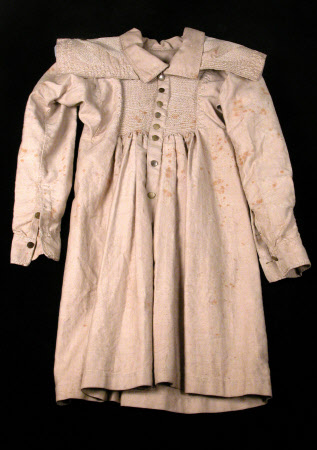Smock
Unknown
Category
Costume
Date
c. 1930 - 1940
Materials
Cotton twill and brass
Measurements
1140 mm (Height)
Place of origin
Unknown
Order this imageCollection
Dudmaston, Shropshire
NT 814587
Caption
Smock frocks were practical outdoor garments, worn by male rural workers to protect their clothes from dirt and the worst of the weather. Made of naturally coloured cotton or linen, they take their name from the distinctive folded and stitched smocked panels, which combined flexibility and fit around the chest and cuffs in what were otherwise loosely fitted designs. By the late 19th century writers like Thomas Hardy were lamenting the disappearance of traditional rural dress, associating the working suits preferred by younger men with increased urbanisation. The smock came to symbolise the preservation of English Folk traditions. This buff cotton smock frock was designed to be durable and practical, with straps of folded fabric across each shoulder for reinforcement, deep side pockets and a full-length buttoned opening at the front so that it could be taken off easily. The embroidered leaves may indicate its association with Captain Geoffrey Wolryche-Whitmore (1881–1969), a pioneering forester who planted swathes of coniferous woodland across Dudmaston’s estate as a cash crop, ensuring its survival during the agricultural depression of the 1930s. Emma Slocombe
Summary
Cream cotton twill smock. Front and back panels to bodice, buttoned from neck to hem with smocking providing fullness to the skirt. Embroidered collar.
Provenance
Dudmaston collection.
Makers and roles
Unknown, costumier
References
Antrobus and Slocombe 2025: Helen Antrobus and Emma Slocombe, 100 Things to Wear: Fashion from the collections of the National Trust, National Trust 2025, pp. 176-177.

